Spearheaded by burgeoning scientific and clinical research literature, psychedelics have reached a level of media coverage and popular interest that has not been seen for over half a century. By “psychedelics,” we are referring to the unique class of substances that includes psilocybin (the active compound found in so-called “magic mushrooms”), LSD, dimethyltryptamine (DMT), ayahuasca, 5-MeO-DMT, and mescaline – each of which occurs in the natural world (except for LSD, which is a semi-synthetic compound).
Flying Chiros, Part II of II
Editor's note: Part I of this article appeared in the Dec. 15, 2003 issue: www.chiroweb.com/archives/21/26/09.html.
Flying chiropractors knew few barriers. Attorney-chiropractor Norman Bartlett of St. Louis earned his private pilot's license at age 72.18 At the "dear old PSC" (Palmer School of Chiropractic) in Davenport, Iowa, students organized a flying club with Donald Pharaoh, DC, as their faculty advisor, although he had not yet earned his wings.19,20
Meanwhile, Palmer graduate and "flying chiropractor" Clarence Gonstead, DC, built a 2,200-foot, all-weather airstrip with a hangar at his clinic in Mt. Horeb, Wisc., for his Beechcraft Bonanza.21 The facility and his aircraft permitted him to make house calls to patients in Chicago, Minneapolis, Milwaukee and St. Louis. He was pleased to make his private airport available to a local flying club, but was not the only chiropractic technique instructor who found the convenience of aviation a boon to the business.

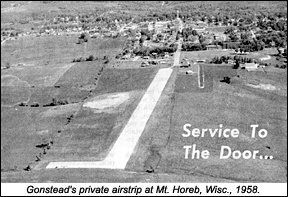
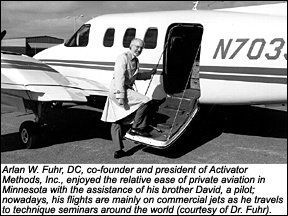
I.N. Toftness, DC, of Prairie du Chien, Wisc., president of the International Basic Technique Research Institute during 1946-47 and inventor of a subluxation-detection device, held a license to fly, as did his wife. The couple traveled extensively in their private aircraft throughout the United States.22 Chiropractors in Iowa organized a Flying Chiropractors Association.23
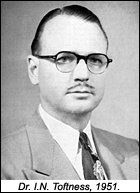
As the world moved deeper into the jet age, chiropractors flew right along. National College alumnus and ACA member Jesse R. Rothenberger was a captain in the U.S. Marine Corps Reserve and a pilot with the Headquarters and Maintenance Squadron 43 at the U.S. Naval Air Station at Willow Grove, Penn. He flew one weekend each month, and also served as an air traffic controller.24 Jimmy Parker, DC, founder of the Parker Chiropractic Research Foundation and the Parker College of Chiropractic in Dallas, made a minor entry in aviation history with his wife when they were the first passengers to arrive at the newly opened Dallas/Fort Worth Airport on Jan. 13, 1974.25
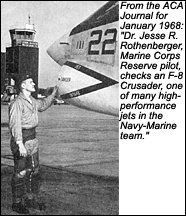
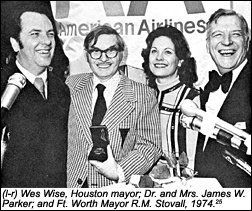
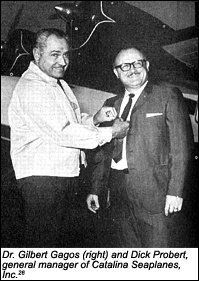
Aviation was a practical tool for some practitioners. Walter B. Wolf, DC, of South Dakota, a 1936 National graduate who was active for years with the NCA/ACA Council on Education (the forerunner of today's CCE), is also remembered for his willingness to attach skis to his Cessna aircraft and "make flying house calls to stranded farming patients on the Dakota prairies."4 Gilbert Gagos, DC, of Hollywood, Calif., maintained a practice on nearby Catalina Island. Although a pilot himself, he preferred to shuttle with a propeller-driven commercial carrier, and his 1,000 trips to and from the mainland over a nine-year period earned him recognition as an "honorary co-pilot" from the company, Catalina Seaplanes, Inc.26 When an earthquake devastated Guatemala City, intern Dan Bookout of the Texas Chiropractic College (TCC), a former Air Force instructor, piloted a twin-engine Beech 18 aircraft on a mission of mercy. His companion on the trip was Darrel D. Prouse, DC, clinic director at TCC. The plane was on loan from Aviation Charter, Inc., of Houston, and the duo flew medical supplies donated by the Church of Christ.27
A love of aviation possesses Leo Kerwin, DC, of Cape Canaveral, Florida, who built a business refurbishing World War II aircraft. He began flying lessons at age 14, and eventually earned an instructor's license and several FAA ratings. Dr. Kerwin graduated from the PSC in 1956, and with the help of a patient, organized a wing of the "Confederate Air Force." His interest in military aviation evolved into a restoration business. In 1988, he helped organize the "Warbird" portion of the Quad-City Air Show in Davenport.28



Perhaps the most remarkable figure in the history of flying chiropractors is Joshua N. Haldeman, DC, a second-generation chiropractor29 who earned his DC from the PSC in 1926.30 Dr. Haldeman, of Regina, Saskatchewan, began flight instruction in 1947 and earned his pilot's license in March 1948,31 at age 45. His new mobility facilitated his political work (as chairman of the National Council of the Social Credit Party); his many trips to Toronto, where he served as a member of the governing boards of the CMCC and the Dominion Council of Canadian Chiropractors (today's Canadian Chiropractic Association); his annual jaunt to lyceum at his alma mater in Davenport, Iowa; and his service as the Canadian member of ICA's Board of Control. The doctor observed that he could cut his travel time to Davenport by 40 hours (83 percent) by flying, rather than taking the train.31 However, this initially quite practical orientation would turn into an obsession and a new career for the adventurous chiropractor.
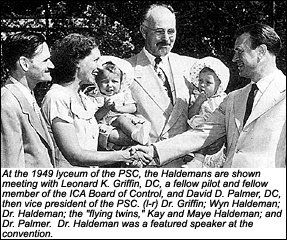
The Haldemans owned two airplanes in the early days: a Luscombe and a Bellanca. When they relocated to South Africa in 1950, the Bellanca was crated and shipped with their household goods. Although no longer a member of the ICA board, Dr. Haldeman maintained his ties with the ICA, encouraged others to establish practices in South Africa,32 and encouraged South Africans to study chiropractic. His air mobility assisted him in his continuing professional activities; in 1952 the Haldemans flew their plane from Pretoria, South Africa to Oslo for an invited presentation to the European Chiropractic Union.33,34 The trip involved flying through Africa, Spain and France, with a stop in London to visit with British chiropractors, before journeying on to Norway.
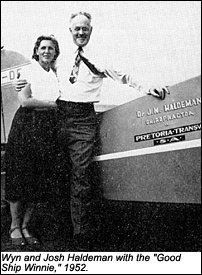
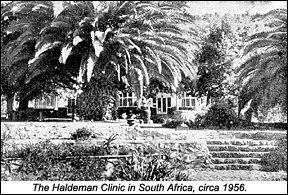
In 1953 Josh, Winnie and their eldest son, Scott, made the first of several extensive air tours of the Kalahari Desert. Historian Bill Rehm, DC, recorded:
Also an explorer, sportsman and political activist, Dr. Haldeman perhaps became best known in South Africa for his expertise in the '"Lost City of the Kalahari Desert." His first expedition into the Kalahari desert was in 1953 to look for the Lost City described by Farini in 1885. The second was an 8,400-mile aerial search at 200 feet off the ground in uncharted desert. Altogether, he made 12 expeditions searching for the Lost City. On every occasion, he was accompanied by Mrs. Haldeman and those of his children who were home. Two books on the Lost City (by F. Goldie and A.J. Clement) devoted large sections to his travels. Though he found no evidence, Dr. Haldeman remained convinced there was indeed a Lost City in the Kalahari desert.35
The following year saw one of their most ambitious adventures, when Josh and Wyn flew 30,000 miles in their single engine plane across Africa, through Asia and on to Australia, perhaps the only private pilots ever to make such a journey. In Australia, Dr. Haldeman was a guest lecturer at several meetings of the Australian Chiropractic Association,34 and met with the Australian prime minister. The couple later wrote a book about their aviation exploits.31
Rehm observed that "By 1970, he had flown across 80 countries and territories of the world. He was co-founder of the Aircraft Owners and Pilots Association of South Africa and a representative on the Civil Aviation Advisory Council and the Air Navigation Regulations Committee of South Africa." He was also a central figure in the intraprofessional feuding among South Africa's chiropractors. Dr. Haldeman's remarkable second career eventually claimed his life, when he was killed in an air crash in South Africa in January 1974.35
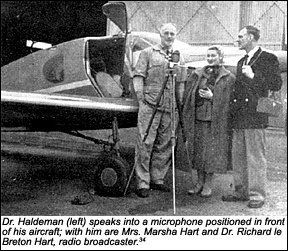

Call them "high flyers"or "space cadets" - chiropractors have winged their way through the twentieth century with enthusiasm. Their escapades in aviation suggest some of that feisty, adventurous spirit that has carried them through many a rough and stormy ride. It is perhaps only fitting that the best-known symbol of chiropractic, a winged seraph, is intended to express "the highest and noblest ideals of the profession... this emblem signifies ... the spirit of chiropractic leading public consciousness upward toward the truths of healing and the attainment of higher physical standards."37
Happy landings!

References
- Keating JC. The influence of World War I upon the chiropractic profession. Journal of Chiropractic Humanities 1994;4:36-55.
- Pope LS. Another incredible journey. Sentinel , October 1968; reprinted in the Journal of the Canadian Chiropractic Association 1970 (July);14(2):31-3.
- Moving pictures of air flight. Fountain Head News 1920 [A.C. 25] (Sept 11);9(52):4.
- In memoriam: Walter B. Wolf, 1913-2002. Chiropractic Journal of Australia 2002 (June);32(2):76.
- New safety plane invented by chiropractor undergoes tests. The Chiropractic Journal (NCA) 1936 (July);5(7):21.
- Keating JC. (Ed.): Protection, regulation and legitimacy: FCLB and the Story of Licensing in Chiropractic . Greeley CO: Federation of Chiropractic Licensing Boards, in preparation.
- Wood JC. In memoriam. Journal of the National Chiropractic Association 1950 (Nov);20(11):56, 58.
- NCA Director of Education flies some 180,000 miles in pursuit of duties. Journal of the National Chiropractic Association 1951 (Aug);21(8):10, 70-1.
- Keating JC, Davison RD. That "Down in Dixie" school: Texas Chiropractic College between the wars. Chiropractic History 1997 (June);17(1):17-35.
- Gin RH, Green BN. George Goodheart, Jr., DC, and a history of Applied Kinesiology. Journal of Manipulative & Physiological Therapeutics 1997 (June);20(5):331-7.
- Keating JC, Fleet GT. Thurman Fleet, DC, and the early years of the Concept-Therapy Institute. Chiropractic History 1997 (June);17(1):57-65.
- Keating JC. 1997 Lee-Homewood Heritage Award: Herbert J. Vear, DC, Chiropractic Scholar. Chiropractic History 1997 (June);17(1):9-13.
- Keating JC. Dr. Bob Thompson: educator, missionary and statesman. Dynamic Chiropractic 2001 (June 4);19(11):31, 42-4.
- Hultgren GM. Against all Odds... but God. The History of the First 50 Years of the Christian Chiropractors Association . Fort Collins CO: Christian Chiropractors Association, 2003.
- Couple renew vows 3,000 feet above Los Angeles. ICA International Review of Chiropractic 1955 (Apr); 9(10):39.
- Chiropractor featured in air show. ICA International Review of Chiropractic 1954 (Aug); 9(2): 24
- State and provincial news: Chiropractors participate in air tour. ICA International Review of Chiropractic 1954 (Dec);9(6):24.
- Age no barrier to chiropractor-flyer. Journal of the California Chiropractic Association 1952 (Feb); 8(7):12.
- Twice as far, twice as fast. ICA International Review of Chiropractic 1958 (June);12(12):17.
- College reports: Palmer College. Digest of Chiropractic Economics 1965 (Mar/Apr);7(5):29-30.
- Gonstead of Wisconsin builds private airport. Digest of Chiropractic Economics 1958 (July/Aug); 1(1):14.
- Research News 1951; April/May:2.
- Meet the flying chiropractors. Digest of Chiropractic Economics 1973 (Nov/Dec);16(3):7.
- Pennsylvania. ACA Journal of Chiropractic 1968 (Jan);5(1):50.
- Chapel WC. First passengers: Dr. and Mrs. Jim Parker, first passengers to set foot on World's largest airport at Dallas/Fort Worth, January 13, 1974. ICA International Review of Chiropractic 1974 (Mar); 27(2):4.
- Chiropractic doctor made honorary co-pilot for traveling on to Avalon. California Chiropractic Association Journal 1969 (Mar);25(7/8):4.
- Mercy mission. Texas Chiropractic College Review 1976 (Apr);2(2):7.
- Kerwin FL. Dr. Kerwin's business is flying high. PCC Alumni News 1991 (Summer);32(2):15.
- Haldeman S. Almeda Haldeman, Canada's first chiropractor: pioneering the prairie provinces, 1907-1917. Chiropractic History 1983:64-7.
- Keating JC, Haldeman S. Joshua N. Haldeman, D.C.: The Canadian years, 1926-1950. Journal of the Canadian Chiropractic Association 1995 (Sept);39(3):172-86.
- Haldeman JN, Haldeman W. The flying Haldemans: "Pity the poor private pilot;" self-published, undated.
- Haldeman JN. Chiropractic in South Africa: Former ICA Board member reports excellent opportunities for chiropractors. ICA International Review of Chiropractic 1951 (May);5(11):12.
- Dr. Haldeman addresses European chiropractors. ICA International Review of Chiropractic 1952 (June);6(12):25.
- Haldeman JN. We fly three continents. ICA International Review of Chiropractic 1954 (Dec);9(6):4-5, 27-8.
- Rehm WS. Who was who in chiropractic: a necrology. In Dzaman, Fern et al. (eds.) Who's Who in Chiropractic, International . Second Edition. Littleton CO: Who's Who in Chiropractic International Publishing Co., 1980, pp. 322-3.
- Haldeman JN. Flying...two continents. ICA International Review of Chiropractic 1952 (Sept);7(3):5-6, 34, 36.
- Official emblem. The Chiropractic Journal (NCA) 1934 (Oct); 3(10):rear cover.
- Fortunate escape. The Chiropractic Journal (NCA) 1937 (Aug); 6(8):28.
Joseph Keating Jr., PhD
Phoenix, Arizona
jckeating@aol.com



